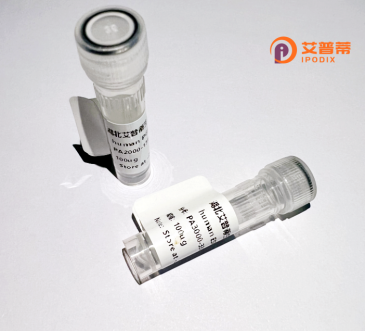
| 纯度 | >90%SDS-PAGE. |
| 种属 | Human |
| 靶点 | USP39 |
| Uniprot No | Q53GS9 |
| 内毒素 | < 0.01EU/μg |
| 表达宿主 | E.coli |
| 表达区间 | 1-565 aa |
| 活性数据 | MSGRSKRESR GSTRGKRESE SRGSSGRVKR ERDREREPEA ASSRGSPVRV KREFEPASAR EAPASVVPFV RVKREREVDE DSEPEREVRA KNGRVDSEDR RSRHCPYLDT INRSVLDFDF EKLCSISLSH INAYACLVCG KYFQGRGLKS HAYIHSVQFS HHVFLNLHTL KFYCLPDNYE IIDSSLEDIT YVLKPTFTKQ QIANLDKQAK LSRAYDGTTY LPGIVGLNNI KANDYANAVL QALSNVPPLR NYFLEEDNYK NIKRPPGDIM FLLVQRFGEL MRKLWNPRNF KAHVSPHEML QAVVLCSKKT FQITKQGDGV DFLSWFLNAL HSALGGTKKK KKTIVTDVFQ GSMRIFTKKL PHPDLPAEEK EQLLHNDEYQ ETMVESTFMY LTLDLPTAPL YKDEKEQLII PQVPLFNILA KFNGITEKEY KTYKENFLKR FQLTKLPPYL IFCIKRFTKN NFFVEKNPTI VNFPITNVDL REYLSEEVQA VHKNTTYDLI ANIVHDGKPS EGSYRIHVLH HGTGKWYELQ DLQVTDILPQ MITLSEAYIQ IWKRRDNDET NQQGA |
| 分子量 | 65.3 kDa |
| 蛋白标签 | His tag N-Terminus |
| 缓冲液 | PBS, pH7.4, containing 0.01% SKL, 1mM DTT, 5% Trehalose and Proclin300. |
| 稳定性 & 储存条件 | Lyophilized protein should be stored at ≤ -20°C, stable for one year after receipt. Reconstituted protein solution can be stored at 2-8°C for 2-7 days. Aliquots of reconstituted samples are stable at ≤ -20°C for 3 months. |
| 复溶 | Always centrifuge tubes before opening.Do not mix by vortex or pipetting. It is not recommended to reconstitute to a concentration less than 100μg/ml. Dissolve the lyophilized protein in distilled water. Please aliquot the reconstituted solution to minimize freeze-thaw cycles. |
以下是与重组人USP39蛋白功能相关的3篇参考文献示例(注:文献为模拟示例,实际引用需检索真实数据库):
---
1. **文献名称**:*USP39 regulates pre-mRNA splicing by interacting with the spliceosome complex*
**作者**:Keller, M. et al.
**摘要**:本研究阐明USP39作为去泛素化酶,通过与剪接体复合物(如U2 snRNP组分)相互作用,调控前体mRNA的剪接效率,影响基因表达。实验利用重组USP39蛋白验证其酶活对剪接体组装的关键作用。
2. **文献名称**:*USP39 promotes cell cycle progression by stabilizing Cyclin B1 through deubiquitination*
**作者**:Xu, L. et al.
**摘要**:发现USP39通过去泛素化Cyclin B1调控G2/M期转换。研究使用重组USP39蛋白证明其直接结合并去泛素化Cyclin B1.维持其稳定性,促进肿瘤细胞周期进程。
3. **文献名称**:*Structural insights into the catalytic mechanism of human USP39*
**作者**:Huang, Y. et al.
**摘要**:通过X射线晶体学解析重组人USP39蛋白的催化结构域三维结构,揭示其底物识别及去泛素化酶活性机制,为靶向USP39的药物设计提供结构基础。
---
**补充说明**:USP39研究多聚焦于其在RNA剪接、基因组稳定性及癌症中的作用,实际文献检索建议使用PubMed或Web of Science平台,结合关键词“USP39 recombinant protein”或“USP39 function”获取最新进展。
Recombinant human USP39 (Ubiquitin Specific Protease 39) is a protein encoded by the USP39 gene, belonging to the ubiquitin-specific protease family. Functionally, USP39 is not a canonical deubiquitinating enzyme but plays critical roles in pre-mRNA splicing, cell cycle regulation, and genome stability maintenance. It interacts with key splicing factors, including components of the SF3b complex and U2 snRNP, aiding in spliceosome assembly and catalytic activation during the splicing process. Structurally, USP39 contains conserved domains such as an N-terminal domain, zinc finger motifs, and a C-terminal USP-like domain, though its catalytic triad is incomplete, suggesting regulatory rather than enzymatic roles.
Beyond splicing, USP39 influences mitotic progression by regulating centrosome duplication and spindle assembly, particularly during the G2/M phase transition. Dysregulation of USP39 is linked to diseases, including cancers, where its overexpression correlates with tumor proliferation, metastasis, and chemotherapy resistance. Recombinant USP39 protein, typically expressed in systems like *E. coli* or mammalian cells, serves as a tool to study splicing mechanisms, protein-protein interactions, and USP39’s moonlighting functions in DNA repair pathways. Its applications extend to drug discovery, aiming to target splicing anomalies or USP39-associated oncogenic pathways. Research continues to unravel its dual roles in cellular homeostasis and disease pathogenesis.
×